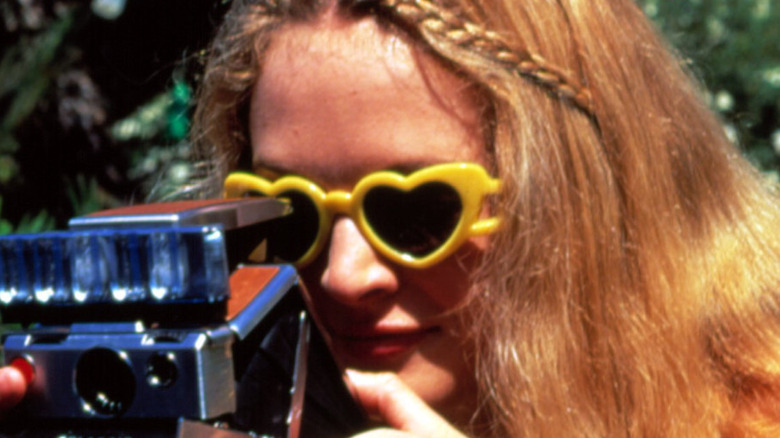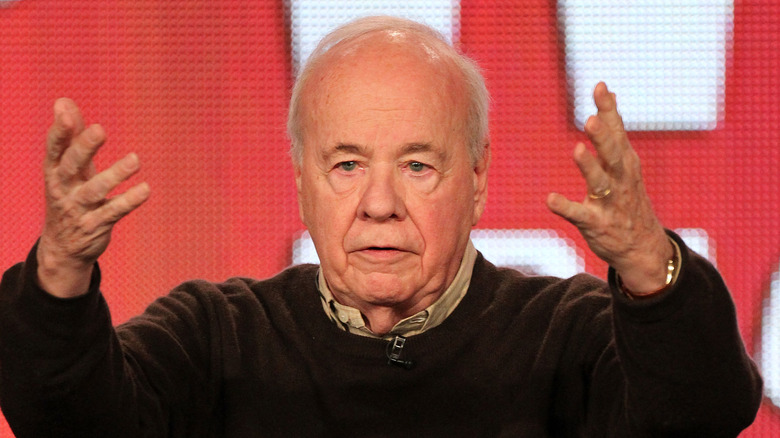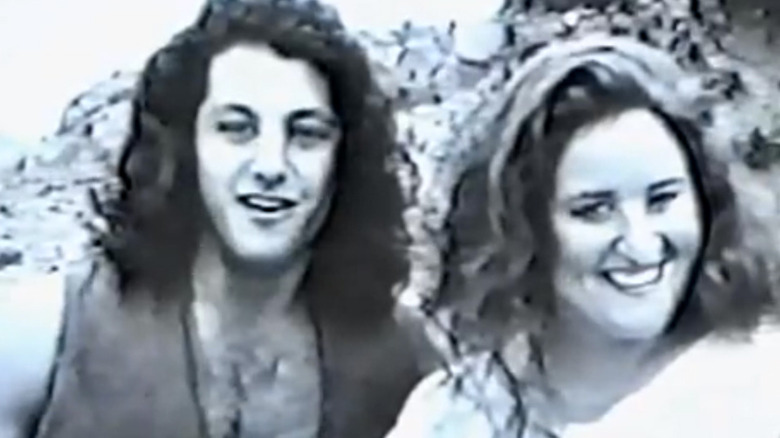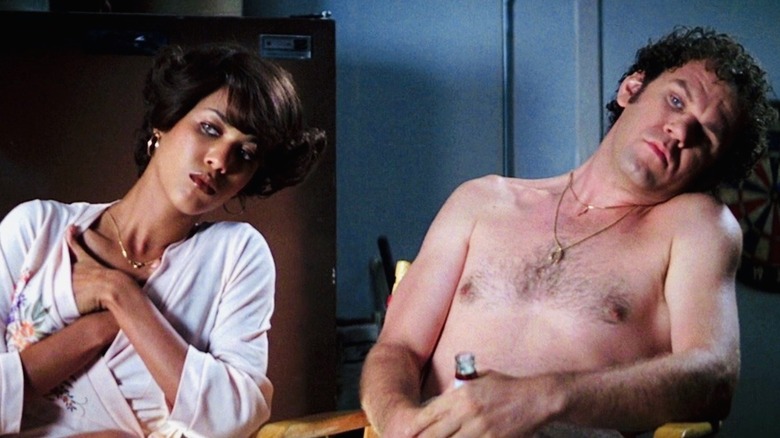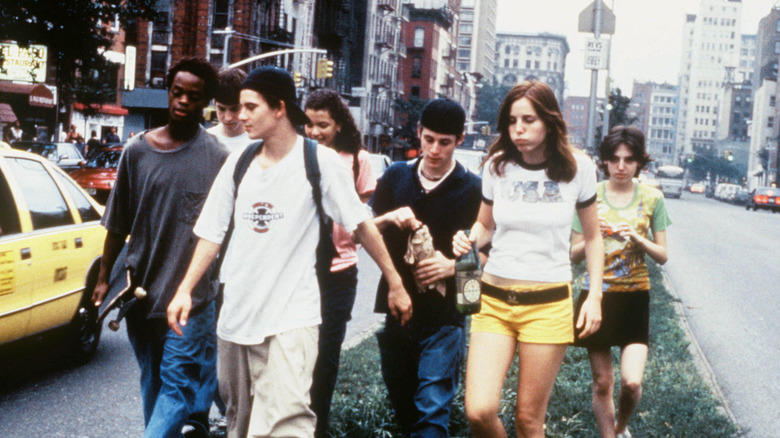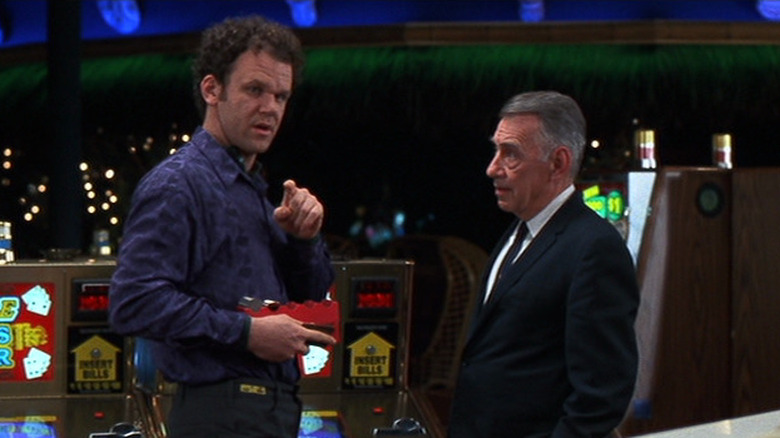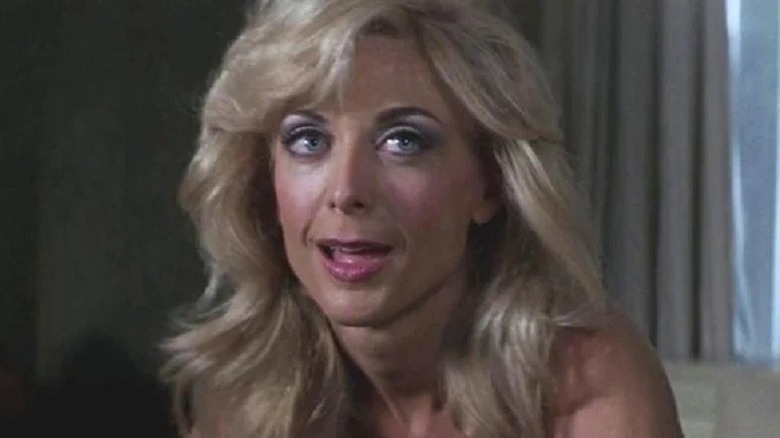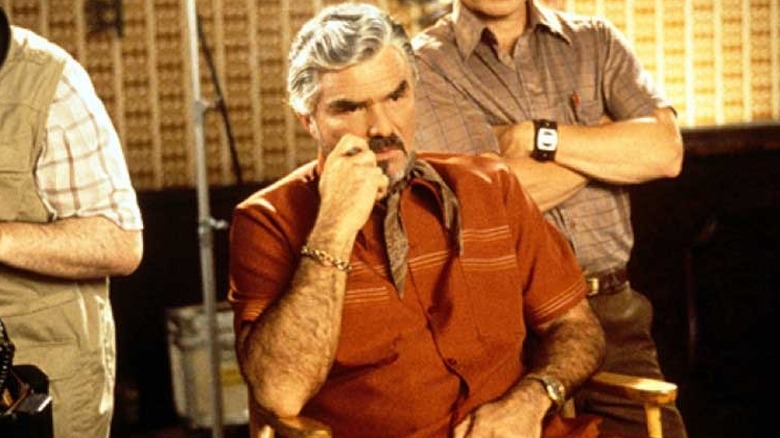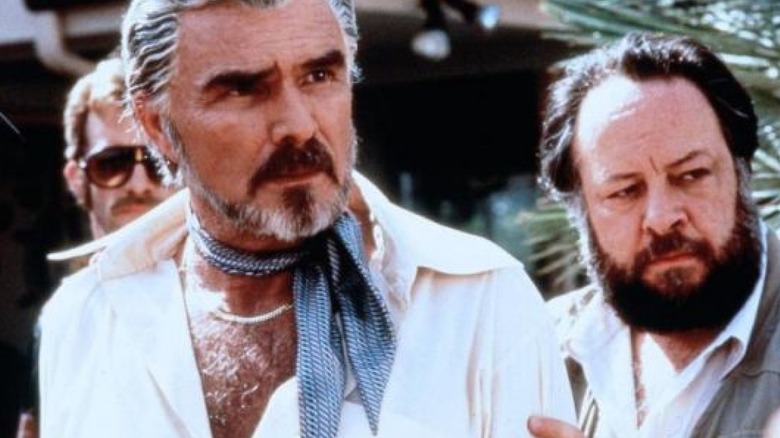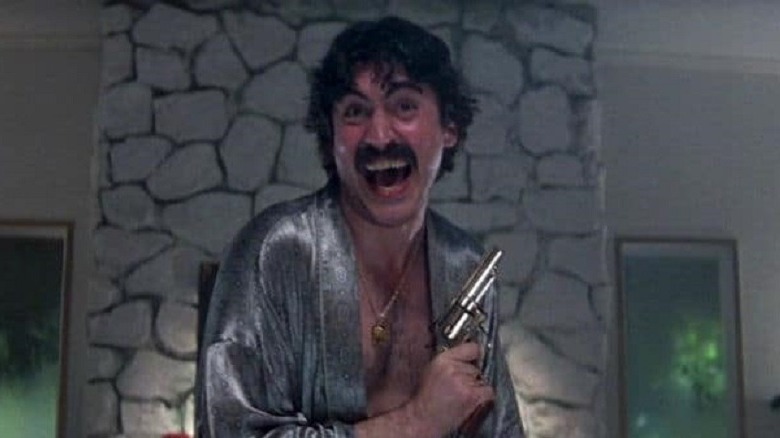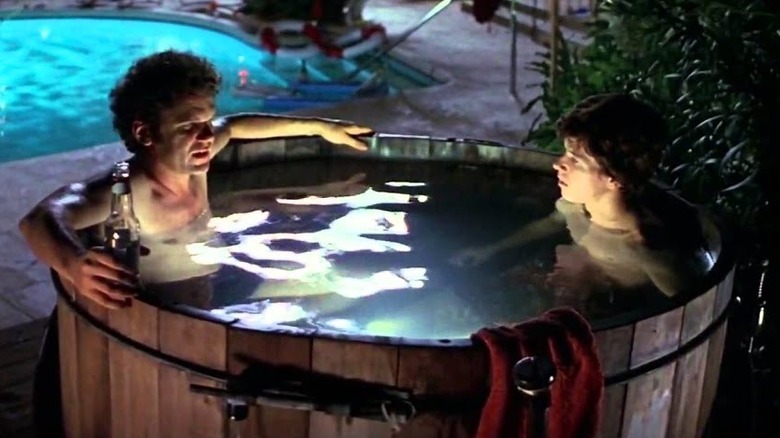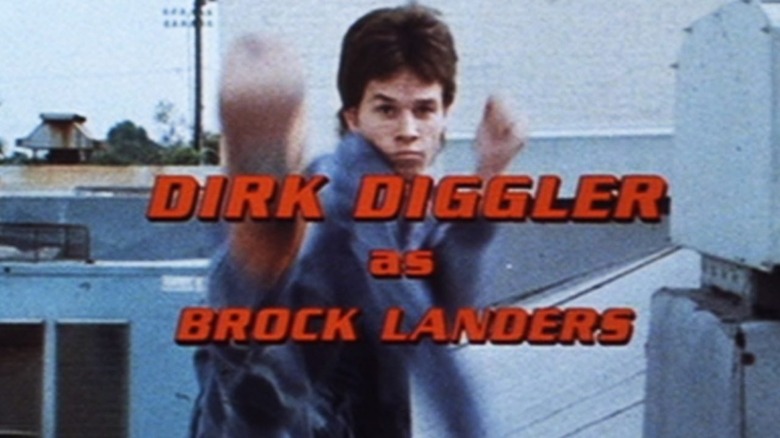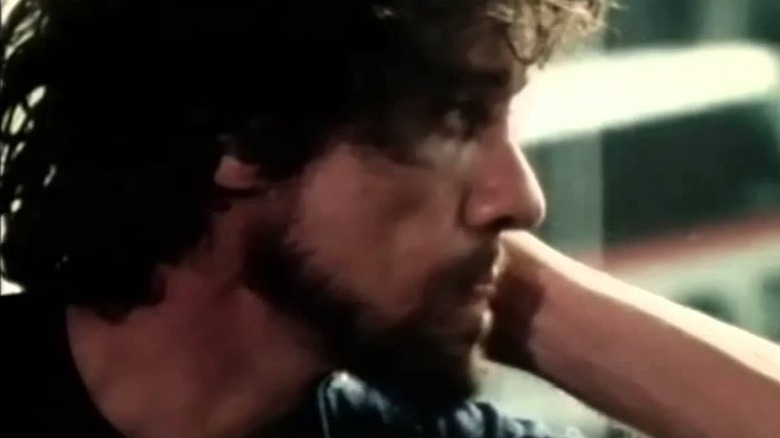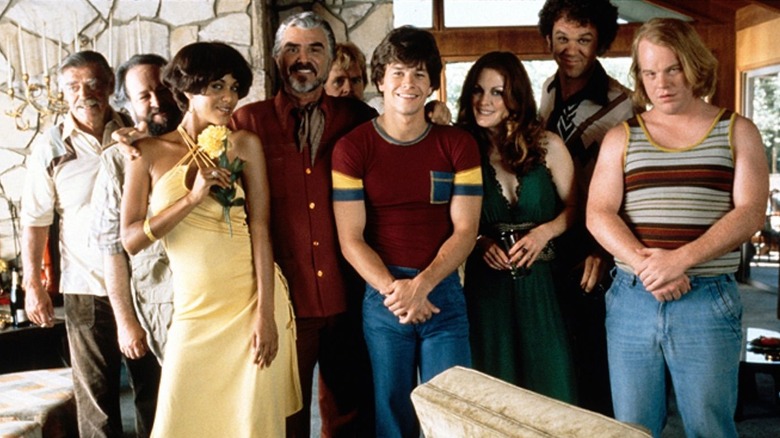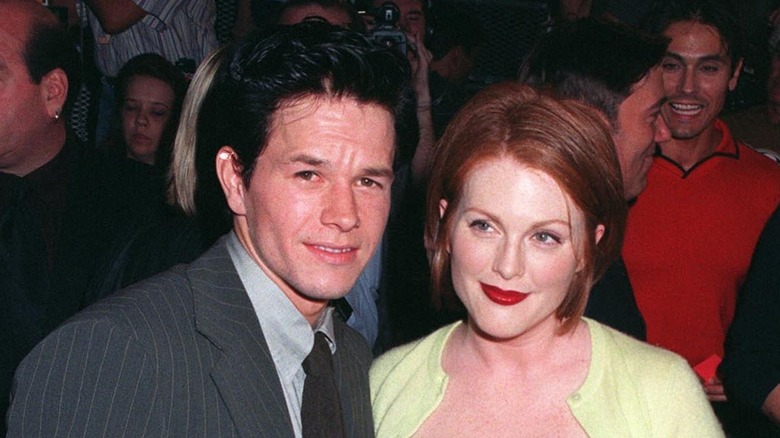The Untold Truth Of Boogie Nights
"Boogie Nights" is a splash of lurid color, a love letter to the seedy yet strangely romantic twilight of pornographic films in California's San Fernando Valley. Love it or hate it, "Boogie Nights" is one of the most unforgettable films of the late 20th century. The cast is full of silver screen giants early in their careers, from Philip Seymour Hoffman to John C. Reilly to Heather Graham to, of course, Mark Wahlberg. Then you bring in Julianne Moore, Burt Reynolds, William H. Macy, Philip Baker Hall, Alfred Molina, Don Cheadle ... this is literally a dream cast.
The director, a 27-year-old wunderkind named Paul Thomas Anderson whose life had seemingly led to this film, has gone on to notch 8 Oscar nods and countless other nominations and wins, landing him on Esquire's list of the 75 most influential people of the 21st century. Yet not only is "Boogie Nights" legendary for what its cast and crew would go on to do, but the movie itself is a dizzying feat in storytelling.
Starting with the long tracking shot at the opening from the streets of the Valley in the '70s to a hot club full of all sorts of beautiful people engaged in debauchery, "Boogie Nights" takes the audience on a vivid ride through the golden years of the porn industry. With sunny days poolside, an endless amount of drugs, and obviously tons of sex, "Boogie Nights" holds the eye from beginning to end, somehow in the process making a movie about the porn industry chock full of family and heart. The story behind this touchstone is almost as dazzling.
Anderson grew up in the showbiz-adjacent Valley
Paul's father, Ernie "Ghoulardi" Anderson, began his career in the 1960s as a Cleveland television horror movie host but eventually found success as a Hollywood voice artist, counting comedians, actors and other Hollywood types among his friends. Ernie had worked with Tim Conway at WJW-TV in Cleveland in the '60s. Conway left to star in "McHale's Navy" but eventually Ernie joined him in Los Angeles and the rest is history.
According to an Esquire article about Paul, Ernie eventually bought a big house in the San Fernando Valley, where he spent time "whiling away the long sunny days with friends like Conway, Harvey Korman, and Robert Ridgely — all comics with a flair for twisted humor." The article goes on to explain how Ernie bought Paul a Betamax camcorder for the boy's 12th birthday and he went on to make vignettes following his father and his zany Hollywood friends. The article even states that Paul's father likely inspired Burt Reynolds' Jack Horner in "Boogie Nights."
There was other inspirations as well. Growing up in the San Fernando Valley, "Porn was always around," Paul explained in an interview with the Philadelphia City Paper. "There were these industrial-looking buildings, with no signage, but you'd see people going in and out; you knew what they were doing."
Anderson first made his Dirk Diggler movie when he was 17
Anderson has been described by many of the people involved in "Boogie Nights" as looking like a kid when they first met him, which makes sense since he was 26 at the time that he was looking to helm his first big Hollywood feature. Yet he'd already made one movie about Dirk and the porn industry, as a 17-year-old high schooler. "The Dirk Diggler Story" was a visual first draft for what he would finally realize in "Boogie Nights."
According to an oral history of the movie at Grantland, Paul Thomas Anderson claims to have had an epiphany about the name "Dirk Diggler" at 17, wrote it on a piece of paper, and began putting together a student film using a camcorder and a Steadicam. Anderson pulled together his friends to play Dirk, Reed, and various others in the low-budget film. He did have one star involved, though: his dad, Ernie.
So "Boogie Nights" was really the refinement of a rough sketch from his teen years. What were you doing at 17?
The script was huge
Paul Thomas Anderson had been pulling in ideas for "Boogie Nights" for years, and according to New Line Cinema's co-founder Robert Shaye in the Grantland oral history, the script was a massive 185 pages at first. In Hollywood, most scripts are about 90 pages, as mentioned by Philip Baker Hall in the above article. On average a script is about a minute a page. There are copies available online of an edited version that's a little smaller, at 153 pages.
There have been other successful long scripts. Tarantino's "Pulp Fiction" script is 176 pages, but while that was the director's breakout film he had already written and directed "Reservoir Dogs" and written "True Romance" before that. Paul Thomas Anderson's only previous feature credit was "Hard Eight," a Sundance Lab independent film that had received critical acclaim but not necessarily commercial success. Taking a risk on such a long script from a relatively untested writer-director isn't a move Hollywood studios are known for.
Oh yeah, and it teetered on the border of an NC-17 rating, a veritable death knell for a studio flick. Basically, this script, and by extension, this director, broke every Hollywood rule.
Passing on Kids led New Line Cinema to Boogie Nights
Back in the '90s, John Lesher was a powerful talent agent. One of his clients was Harmony Korine, a talented young writer whose career began when he wrote "Kids" at age 19. As Deadline explained in a 2013 article, Lesher championed Korine for years while an agent at UTA and Endeavor, and Lesher continued that support as a producer. Yet Lesher had another wunderkind client at the time: Paul Thomas Anderson.
Michael de Luca, an exec at New Line Cinema at the time, told Grantland, "I was talking with John [Lesher] about the movie 'Kids.' I passed when he brought it to New Line; then I saw the movie and was really impressed. Just as a joke, I said to him, 'Don't let me pass on something this cool again,' and later, under those auspices, John said, 'Remember when you said don't let you pass on something cool?'" Lesher then described in the article how he met de Luca for drinks, gave him the script for "Boogie Nights," and the next day they were in business.
According to Sharon Waxman, as excerpted in that same article, another reason for de Luca to pick up "Boogie Nights" may have been that he was a "bad boy" at the time. "He loved that life and he lived that life," Waxman said.
Whether it was good agenting or simply a case of party boy meets party script, it seems as destined as Dirk Diggler for greatness.
Anderson's first feature was a Sundance indie with an amazing cast
At 23, Anderson got into the Sundance Film Festival with his short film "Cigarettes and Coffee" (not to be confused with Jim Jarmusch's later film, "Coffee and Cigarettes"). An Esquire article about the director details how he came back the following year to the Sundance Lab and expanded on "Cigarettes and Coffee" with his first feature, "Hard Eight."
Paul Thomas Anderson titled it "Sydney" when he first conceived the idea in high school after watching a short Philip Baker Hall scene as a consigliere named Sydney in "Midnight Run." That was the working title for the film, and he was infuriated when his backers took final cut and the name away from him (he still prefers the title "Sydney," according to Esquire). The movie had a budget of $3 million and starred Hall and John C. Reilly as the leads, Gwyneth Paltrow and Samuel Jackson as top supporting actors, plus Philip Seymour Hoffman early in his career.
For a debut film from a 25-year-old kid made at Sundance Lab, "Hard Eight" notched great reviews (including one from Roger Ebert) and paved the way for Anderson's first studio feature. The budget for "Boogie Nights" was $15 million and there were more actors and sets, but Hall, Reilly and Hoffman all returned to work with Anderson on a movie that would help propel the careers of all four.
Nina Hartley: Real-life porn star, onscreen cuckold
It's hard to think of a more defeated man than William H. Macy's Little Bill in "Boogie Nights." On set, Little Bill makes things happen. Then he comes home to his wife, who spends most of the movie having sex with other men and chiding Bill for trying to break it up. "Go away Bill, you're embarrassing me," she says in one scene when her husband finds her in the act. Eventually her goading turns lethal when Little Bill kills her, her lover, and then himself at Jack's 1980 New Year's Eve party.
Little Bill's wife is presumably a porn star, which makes even more sense when you realize she's played by Nina Hartley, who is, in fact, a porn star in real life. "I got called in because Paul had been a fan of mine when he was younger," Hartley says in the Grantland oral history article. The article goes on to explore the fact that since she was a porn star, as were the men she was having sex with in the film, she wanted to have real sex to speed things up.
She was also a porn guide for many of the women on the set. Which makes sense, since not only has she appeared in over 1,000 adult films, according to the New York Daily News, but she's also a female activist and sexual therapist featured in magazines such as Cosmopolitan. And even in her 50s and happily married, Nina still does porn.
Warren Beatty almost played Jack Horner
Despite the fact that the movie was an at times depressing story about the porn industry, a lot of actors were circling the script. For example, according to the Grantland article, Drew Barrymore was Roller Girl at one point. The role of director/producer Jack Horner, however, was offered to a lot of big talent. Bill Murray, Harvey Keitel, Sydney Pollack and Albert Brooks were supposedly all offered the role. But Paul Thomas Anderson discussed it extensively with Warren Beatty.
As Anderson says in an interview with Charlie Rose, Warren had shown a lot of interest even though Burt Reynolds had been who Anderson was thinking of when he wrote it. Eventually, Anderson made a realization that Beatty didn't necessarily want to play the director. "I started to figure out that Warren really wanted to play Dirk Diggler (Mark Wahlberg). 'You don't really want to play Jack Horner. You want to be the kid in this movie.' He said, 'Yeah.'"
Horner eventually went to Burt Reynolds, and it's hard now imagining anybody else playing it. Though it appears that Reynolds brought quite a few challenges to the production.
Burt Reynolds didn't like Anderson or the movie
In an interview with GQ, Burt Reynolds was asked if he'd work with Anderson again. His answer? "I don't think so. Personality-wise, we didn't fit." According to the Grantland oral history, there was even a moment when Anderson gave Reynolds perhaps less respect than he deserved and it supposedly came to blows. According to the Washington Post's obituary for the actor, Burt Reynolds clarified to Conan O'Brien that he hadn't punched Anderson, but wanted to. "No, I didn't want to hit him in the face — I just wanted to hit him."
The obituary goes on to say that Reynolds was so unhappy with the film and his place in it that he fired his agent after seeing it for the first time. It was ironic, then, that he won his only film Golden Globe for his turn as Jack Horner. Plus he was nominated for the best supporting actor Oscar, eventually losing to Robin Williams for his turn in "Good Will Hunting."
Whether he liked it or not, at least he had a really nice toupee in the film.
Celeb dads inspired the firecrackers
One of the most intense, strange scenes in "Boogie Nights" occurs toward the end when Dirk, Reed (John C. Reilly), and Todd Parker (Thomas Jane) are sitting in the living room of a crazy rich man's house, looking to rip him off by selling him some fake dope. There's a random boy just walking around throwing firecrackers at the floor.
Many of the cast discuss how that was the craziest scene in the whole film, where Mark Wahlberg's reaction tells an amazing visual story, and in large part that was due to the unexpected randomness of the constant mini-explosions. Robert Downey Sr. says in the oral history, "That idea came from a scene in my movie 'Putney Swope.' It's one of Paul's favorites. My thing was the Asian guy who's throwing around firecrackers and just doesn't say a word."
Another inspiration, though, was Anderson's father. Ernie "Ghoulardi" Anderson, according to the Esquire article, "liked tossing firecrackers around. Once, he stuck a firecracker in a dead frog and blew it up on camera."
Two showbiz fathers with a fondness for minor incendiaries inspired one of the most insane scenes in a movie full of intense sequences. The '60s and '70s really must have been an explosive time to be a celebrity.
The original Reed Rothchild made his own impact
A few characters, or at least character names, made it to "Boogie Nights" from "The Dirk Diggler Story." One of those is Reed Rothchild, Dirk's best friend in the porn industry. In the original, though, Reed was very different.
Reed was played by Eddie Dalcour, a bodybuilder who was also Dirk's gay lover in that original iteration. Dalcour features prominently in the student film since he was Dirk's best friend. There's even a scene where they're both together in a hot tub, although that's for a gay porn movie they were supposed to be shooting. While that element of the Dirk/Reed relationship didn't make it into "Boogie Nights," one Dalcour item did — Reed's hot tub poem.
According to the oral history, Dalcour was constantly trying to get Anderson to crack up on the set and was even invited to be in "Boogie Nights" — although by that point he had begun his career as a Christian minister, which would've been tough to square with a film about drugs and porn.
One of his improvisations was the poem that John C. Reilly recites as Reed while in the hot tub with Dirk. It's a poem about love and honey trees and bees, one so bad yet so amazing because of how well it sets up this friendship that's rock solid through thick and thin.
Anderson's early films wound into Boogie Nights
Anderson had been making movies since he was 12, and some of those early ones were actually scripted films. In fact Anderson's early films all seemed to march toward what he would eventually realize in "Hard Eight" and "Boogie Nights."
Obviously "The Dirk Diggler Story" is a major stepping stone, from the tale of Dirk's rise and fall to the fact that recording "The Touch" was featured in both as an example of Dirk's failed second career. But in the Esquire article, it becomes striking how much of these films began when Anderson was still too young to actually buy porn. It mentions how he first told a teacher he was going to make a movie called "Sydney" based solely on the snippet of Philip Baker Hall he'd seen in "Midnight Run." As a young teen, however, he made a "Miami Vice" parody called "Brock Landers," which went on to be the name of Dirk's monumental X-rated action series. Anderson also made a "Young Guns" parody called "Young Buns," with erotic undertones. If nothing else, Anderson was a student of film from a very early age, and didn't just want to watch them but wanted to be part of them as well.
Boogie Nights was based on the life of John Holmes
John Holmes was a very successful adult film actor known for having a large member, a heavy drug addiction and, eventually, his possible role in the Wonderland Murders. According to the Esquire article, Paul Thomas Anderson told his childhood friend while in high school that the idea for his next movie was inspired by the sad life of Holmes.
In a 1997 interview, Anderson explains how Dirk's career was very similar to that of Holmes: "With the '80s and the drugs, everything's taken a toll on him. That happened in John Holmes' life and it was reflected in the character he played [Johnny Wadd]. We did the same thing with Dirk, and in the movie I blame the drugs and ego-building." In that same interview, he also specifically mentions the early Johnny Wadd films as examples of great storytelling in porn.
There was also a John Holmes documentary, called "Exhausted," that was one of the inspirations for Anderson to shoot "The Dirk Diggler Story" as a mockumentary. It was such a big inspiration that the documentary was even an added feature on a Criterion laserdisc of "Boogie Nights," and Anderson even pointed out in the commentary on the laserdisc that it was a "major influence."
It's a shame that Holmes ended up dying of AIDS almost 10 years before a film loosely based on him would end up becoming a highly acclaimed Hollywood feature.
Smaller budgets led to period realism
The budget for "Boogie Nights" was $15 million, 5 times as much as Anderson's previous film and equal to about $25 million today, but still not a lot, especially considering the talented cast and crew. For that reason they couldn't build massive houses on the studio lot or hire designers to hand make period-perfect clothing. So the team had to go digging.
In the Grantland article, Nicole Ari Parker, who plays Becky Barnett, tells how Don Cheadle wore a Sonny Bono vintage original and she wore a dress from the Pointer Sisters. Costume designer Mark Bridges tells how he and his assistant flew to a warehouse in the Midwest called Hullabaloo that was full "of unused clothes from different periods. We spent $12,000 grabbing up incredible suits and pants. I found roller skates with red Lucite wheels and we got so many things: Scotty's red jacket and a lot of stuff the cast ended up wearing in the New Year's Eve scene."
A central set was Jack Horner's swinging pad, complete with pool. But most houses in Los Angeles had been updated between 1978 and 1996. They finally found a house in West Covina that the owners hadn't had enough money to update. According to cinematographer Mark Elswit, "They had a kidney-shaped pool, a flagstone fireplace, all the original electric appliances, all the original light fixtures and almost the original draperies."
Could you imagine renting your house out for a few months so people could film a movie about drugs, murder, and porn? Hopefully they got enough money to remodel after that.
Mark Wahlberg probably wouldn't do Boogie Nights again
A final shocking fact to come out of "Boogie Nights" is that its star, a man still known at the time as an underwear model and teen idol called Marky Mark, has said that he probably wouldn't do "Boogie Nights" again despite having just a few acting credits at the time. Yes, Mark Wahlberg said in a 2017 appearance that he hopes God forgives him his poor acting choices, and that "Boogie Nights" is at the top of the list.
There was a lot of outcry about him negating the movie that gave him serious acting cred. As Julianne Moore put it to Andy Cohen, "Oh my God, I think he should thank God for 'Boogie Nights.' It made his career!"
According to Wahlberg, he's only ever kept one prop from a movie. That prop? Of course, he kept the prosthetic he had to wear to simulate Dirk Diggler's large penis.
